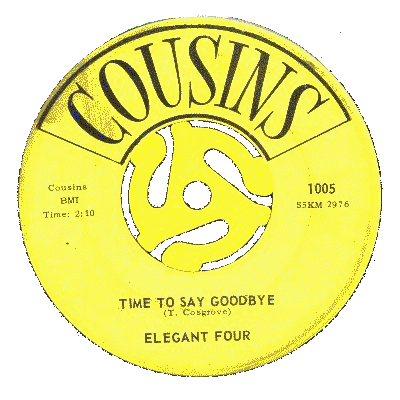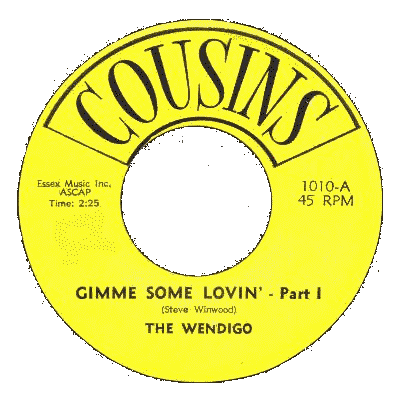Danny Cronin wanted to be a rock-and-roll star.
At the time,
Then one day, Danny tells us about this guy he knows who has been playing the guitar
Tommy Cosgrove was a nice guy - and his mother, Pat, was even nicer. She loved having kids hang around in the apartment.
Then it happened - one of those things that can change a life: Jay left the band, and Eddie Ray was filling in for him, when he wasn't busy with his own band, the Deltairs. I was present at one of the Elegants' practice sessions, ( I was in awe, too! ), and Tommy says: "We heard that you play the organ; we've been looking for something to fill in the background, and an organ might do it. Why don't you bring it tomorrow, and we can see how it works out...". WOW! I was floored. It was definitely a Ringo Starr-type moment - one of the luckiest guys on earth.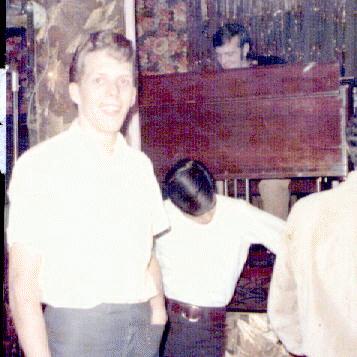 He had moved away from the South Bronx (to 176th Street near Jerome Avenue), but we still saw him now-and-then. His uncle Kenny (who was barely two years older) still lived in the neighborhood.
He had moved away from the South Bronx (to 176th Street near Jerome Avenue), but we still saw him now-and-then. His uncle Kenny (who was barely two years older) still lived in the neighborhood.  It was always Danny who talked us into taking the long subway ride down to the Brooklyn Fox, and Murray-the-K's outstanding live stageshows. It was also Danny that talked us into forming a singing group - though only one of us - Jimmy Gott - could actually sing. (Gott later won two Purple Hearts and a Bronze Star with the Marines in Qui Nohn, Vietnam; I'm told he is the proprietor of a SCUBA dive shop in the Bronx today.)
It was always Danny who talked us into taking the long subway ride down to the Brooklyn Fox, and Murray-the-K's outstanding live stageshows. It was also Danny that talked us into forming a singing group - though only one of us - Jimmy Gott - could actually sing. (Gott later won two Purple Hearts and a Bronze Star with the Marines in Qui Nohn, Vietnam; I'm told he is the proprietor of a SCUBA dive shop in the Bronx today.)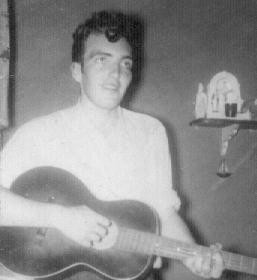 I had been fooling around with a cheap reed organ belonging to my (much older - heheh) brother; it was really just an accordian laid out flat, with a built-in blower to power the reeds. It even had chord buttons like an accordian - which helped a lot: I never could figure how those trained piano-pounders could keep their left-hand fingers moving around; it was like playing two things at once. Lessons? We don' need no steenking lessons!
I had been fooling around with a cheap reed organ belonging to my (much older - heheh) brother; it was really just an accordian laid out flat, with a built-in blower to power the reeds. It even had chord buttons like an accordian - which helped a lot: I never could figure how those trained piano-pounders could keep their left-hand fingers moving around; it was like playing two things at once. Lessons? We don' need no steenking lessons! So we got together and tried singing: Kenny, Jim, Danny, and me... we called ourselves "Fourescents". Danny tried all sorts of ways to get us involved and committed to practicing and making contacts "in the business" - but the rest of us really weren't that enthusiastic.
So we got together and tried singing: Kenny, Jim, Danny, and me... we called ourselves "Fourescents". Danny tried all sorts of ways to get us involved and committed to practicing and making contacts "in the business" - but the rest of us really weren't that enthusiastic.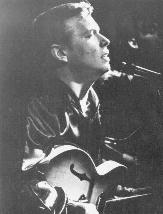 since he was six or seven years old. The guy's been playing ten years - and he's only sixteen... and he is GOOD! He talks us into visiting his home; when we get there, here's this pasty-white blond kid, asleep on the couch, with a real Fender Jaguar guitar still strapped across his bare chest. It was Tommy Cosgrove - whom I would soon come to know very well.
since he was six or seven years old. The guy's been playing ten years - and he's only sixteen... and he is GOOD! He talks us into visiting his home; when we get there, here's this pasty-white blond kid, asleep on the couch, with a real Fender Jaguar guitar still strapped across his bare chest. It was Tommy Cosgrove - whom I would soon come to know very well.
(Tommy seemed to hate daylight. After a while, it seemed I did, too.) Tom awoke, played a few things for us, then Danny got down to business: he wanted Tom's band, the Elegants, to permit us to sing at their next engagement. We did - if you can call it "singing". . .we were just four guys singing the same tune without any sort of harmony, and it didn't go well.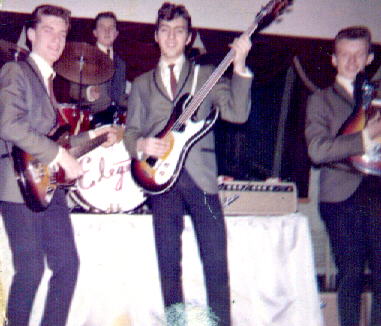 There was always a live "jam session" going on at Tommy's house, and Pat actively recruited teens to come and watch her "child prodigy". Most were in awe of his talent - and that displayed by the other members of the band, too. Billy Dennis, the baby-faced drummer,
There was always a live "jam session" going on at Tommy's house, and Pat actively recruited teens to come and watch her "child prodigy". Most were in awe of his talent - and that displayed by the other members of the band, too. Billy Dennis, the baby-faced drummer, also had been around the instrument most of his life; his father was a drummer in the musician's union. One look at Billy's forearms gave him away: he had arms like Popeye - from years of banging drums, even though he was only 15. Dennis Sousa - who'd rather play the guitar than the bass he was "forced" to - never lost his guitar-picking technique. He used a thumb pick on his Mosrite bass all the time. Jay Dieckmann played rythm guitar on a second Fender Jaguar - a big step up in price from the 3/4-size Stratocaster, popular even today.
also had been around the instrument most of his life; his father was a drummer in the musician's union. One look at Billy's forearms gave him away: he had arms like Popeye - from years of banging drums, even though he was only 15. Dennis Sousa - who'd rather play the guitar than the bass he was "forced" to - never lost his guitar-picking technique. He used a thumb pick on his Mosrite bass all the time. Jay Dieckmann played rythm guitar on a second Fender Jaguar - a big step up in price from the 3/4-size Stratocaster, popular even today.
In a month, I had learned enough of the chords to follow along with the Elegants - and surprisingly,
It all seems to run together from then on. . . but things happened fast. I bought a very expensive portable Vox Organ with reversed-color keys (same as the Dave Clark Five), but found out it wasn't very good, even though it looked beautiful on stage.
Back to the Brill Building (on Broadway - whose recording studios have produced more hit records than any other in the world), and we started recording an LP album. By this time, Tommy suggested a new name for the band, more in tune with the times: Wendigo. (A Canadian Indian name for a "spirit that comes on the wind".)
The Wendigo was a professional, class act; we knew the difference between entertainers (who give the customers what they want to hear) and "artists", who demand you listen to what they want to play.
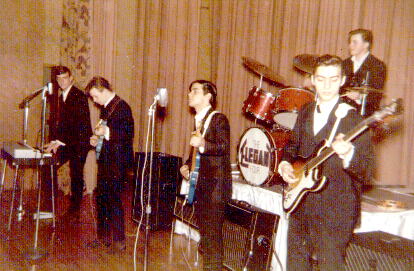 I seemed to fall right in with their timing. I had bought a no-name Italian-made Electronic organ, preferring it over the similar Farfisa that was common in Bronx bands back then - and they said I was ready for my first "job" with them. When I found out it was far away in Lambertville, NJ, I was glad - no one from the Bronx would see me if I screwed up. Little did I know it was a national "Battle of the Bands" contest. It turned out we couldn't win, anyway, since we were considered "professionals": we had already signed a record deal. Besides - the amateur group that did win that day (with one member playing a strange electronic accordian from Cordovox), introduced a new song. It was Garry Lewis and the Playboys, and you can hear that Cordovox in the song they played that day: "This Diamond Ring".
I seemed to fall right in with their timing. I had bought a no-name Italian-made Electronic organ, preferring it over the similar Farfisa that was common in Bronx bands back then - and they said I was ready for my first "job" with them. When I found out it was far away in Lambertville, NJ, I was glad - no one from the Bronx would see me if I screwed up. Little did I know it was a national "Battle of the Bands" contest. It turned out we couldn't win, anyway, since we were considered "professionals": we had already signed a record deal. Besides - the amateur group that did win that day (with one member playing a strange electronic accordian from Cordovox), introduced a new song. It was Garry Lewis and the Playboys, and you can hear that Cordovox in the song they played that day: "This Diamond Ring". From then on, we worked non-stop. The next job: opening for The Byrds at a Hunter College concert. The only problem: The Byrds didn't show; they substituted folk singer Buffy Saint Marie. (She really sucked, by the way...) The band's name, The Elegants, was too dated - and too easily confused with the '50s group, the Elegantes - so it became Elegant Four, and a period of really faggy-looking stage clothing took place. (Hey - if it worked for the Kinks, why not us ?)
From then on, we worked non-stop. The next job: opening for The Byrds at a Hunter College concert. The only problem: The Byrds didn't show; they substituted folk singer Buffy Saint Marie. (She really sucked, by the way...) The band's name, The Elegants, was too dated - and too easily confused with the '50s group, the Elegantes - so it became Elegant Four, and a period of really faggy-looking stage clothing took place. (Hey - if it worked for the Kinks, why not us ?)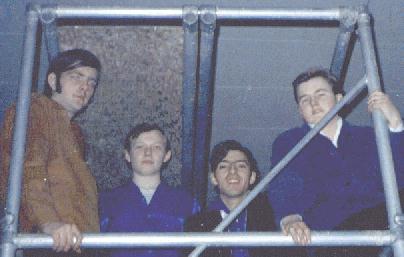 I soon traded it in for a ten-year-old Hammond B-3 and Leslie (rotating) Speaker that cost more, used, than a new compact car. Mercury Records picked up distribution rights for "Time to Say Goodbye",
I soon traded it in for a ten-year-old Hammond B-3 and Leslie (rotating) Speaker that cost more, used, than a new compact car. Mercury Records picked up distribution rights for "Time to Say Goodbye", reissuing it on the Mercury label, and our recording debuted in national distribution as one of two "Best Bets" for topping the charts in the weekly trade magazine, Cash Box. (The other best bet that week: "Down in the boondocks"...) Pete Santorra joined the group, playing rythm guitar on a Gretsch identical to that played by his hero: George Harrison. Since some of us were still under 18, we couldn't get cabaret cards, and were prevented from playing in bars - legally, anyway. But that didn't stop us from playing everywhere else. Around this time, we found that another Bronx group had also been signed by Mercury - the Trenchcoats from Fordham Road.
reissuing it on the Mercury label, and our recording debuted in national distribution as one of two "Best Bets" for topping the charts in the weekly trade magazine, Cash Box. (The other best bet that week: "Down in the boondocks"...) Pete Santorra joined the group, playing rythm guitar on a Gretsch identical to that played by his hero: George Harrison. Since some of us were still under 18, we couldn't get cabaret cards, and were prevented from playing in bars - legally, anyway. But that didn't stop us from playing everywhere else. Around this time, we found that another Bronx group had also been signed by Mercury - the Trenchcoats from Fordham Road. 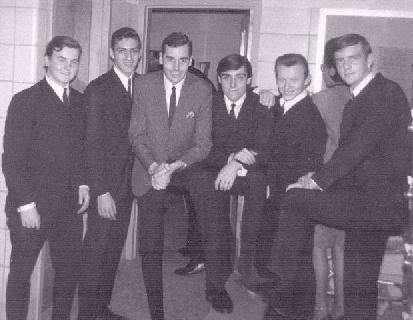 (These guys had repeatedly "flunked" auditions to play at local high school dances - so they made their way to the Village, "passing the hat" instead of getting paid. Thus, they followed the same path as Jimmi Hendrix.) Mercury made them change the band's name as well - to The Blues Magoos. We Started doing the WMCA "Good Guy" road shows, usually with Harry Harrison - but it didn't get the record playing on the New York stations. It was strange - the record was selling well all over the country. . . but not in New York.
(These guys had repeatedly "flunked" auditions to play at local high school dances - so they made their way to the Village, "passing the hat" instead of getting paid. Thus, they followed the same path as Jimmi Hendrix.) Mercury made them change the band's name as well - to The Blues Magoos. We Started doing the WMCA "Good Guy" road shows, usually with Harry Harrison - but it didn't get the record playing on the New York stations. It was strange - the record was selling well all over the country. . . but not in New York. Cousins and Mercury released only one cut from the album, as a single: "Gimme some Lovin'", split right in the middle, as part one and part two. Some Bronxites still have a copy, and may think it sounds a little funny compared to our live performances. They're right: it is a re-recording with Bill Killoran playing the organ. Now, Bill is a great musician - but he never learned how to do the "yuk-yuk" sound properly on the Hammond!
Cousins and Mercury released only one cut from the album, as a single: "Gimme some Lovin'", split right in the middle, as part one and part two. Some Bronxites still have a copy, and may think it sounds a little funny compared to our live performances. They're right: it is a re-recording with Bill Killoran playing the organ. Now, Bill is a great musician - but he never learned how to do the "yuk-yuk" sound properly on the Hammond!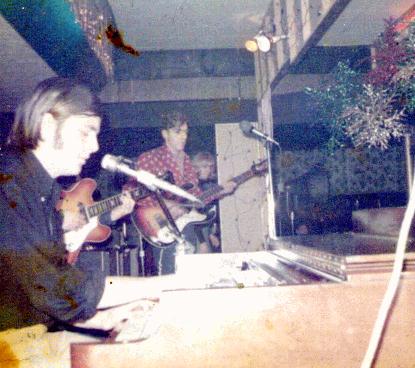 If you ever saw our show, I'm sure you enjoyed it - and if you were in the Bronx in the mid-late '60s, you had plenty of opportunity. We "opened the show" at a lot of concerts - from the Buckinghams and the Beach Boys - to Screamin' Jay Hawkins and the Animals. The Tolentine dances were a Bronx institution - and we literally spent months as the house band at "the End" bar - at the seaside end of Castle Hill. From the "Big Toe au go-go" (The Red Mill) to the silly little "Launching Pad", we were, for a while, The Bronx's Own Band.
If you ever saw our show, I'm sure you enjoyed it - and if you were in the Bronx in the mid-late '60s, you had plenty of opportunity. We "opened the show" at a lot of concerts - from the Buckinghams and the Beach Boys - to Screamin' Jay Hawkins and the Animals. The Tolentine dances were a Bronx institution - and we literally spent months as the house band at "the End" bar - at the seaside end of Castle Hill. From the "Big Toe au go-go" (The Red Mill) to the silly little "Launching Pad", we were, for a while, The Bronx's Own Band.
( Added three years later )
Return to the Tapestry Project
